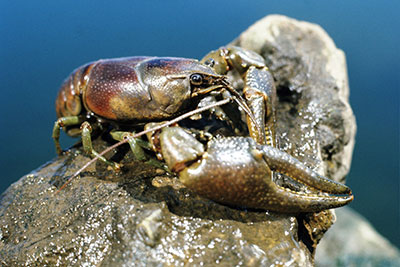Impacts to Natural Areas
Many aquatic invasive species, while they may have no direct impact on humans, can have drastic impacts on natural areas. Because they are usually very adaptable, grow quickly and reproduce prolifically, they are often able to successfully outcompete native species in an ecosystem.
 Rusty Crayfish by Wisconsin DNR
Rusty Crayfish by Wisconsin DNRThe goal of this project is to raise awareness about invasive species and to turn that awareness into action to prevent and to manage current and future invasions. The project consists of lesson plans and corresponding hands-on items designed to teach the story about invasive species. Each lesson plan has been aligned with Next Generation Science Standards, Common Core Standards, and Maryland Environmental Literacy Standards. Lesson plans in each module include activities suitable for Grades 3-12. To download the module, click the link below.

Boulder Booger Bling -- Grades 3-8  Supplemental Pictures
Supplemental Pictures
Students will learn about the microscopic structure of Didymo, explore how structure lends itself to the ability of the diatom to invade, and examine the environmental damage Didymo blooms cause through the use of scientific modeling.
Chestnut Acres -- Grades 9-12  Introduction to Transgenics
Introduction to Transgenics
Students will research different sides of the transgenic American Chestnut tree debate and will decide on whether or not they should plant transgenic American Chestnut trees in a fictional town named Chestnut Acres.
Design an Aquatic Invader -- Grades 3-5  Supplemental Pictures
Supplemental Pictures
Students will design their own aquatic invaders in order to learn about how the Rusty Crayfish has adapted to its environment and why it is considered invasive.
Macrophyte Muddle -- Grades 6-12
Students will investigate the relationship between macrophyte populations and dissolved oxygen concentration as an indicator for aquatic ecosystem health relative to Rusty Crayfish invasion.
Mold, Blight, and Chestnut Strife -- Grades 6-8
Students will observe the growth and spread of mold to understand how Chestnut Blight grows and spreads in living American Chestnuts.
Nuisance Nutria -- Grades 6-8
Students will simulate what may happen to a muskrat colony if the invasive Nutria becomes established in a marsh.
Tidal Marsh Web -- Grades 3-5
Students will simulate what happens to a tidal marsh food web with the introduction of Nutria.
Tree Trouble -- Grades 3-5
Students will model how the loss of the American Chestnut impacted wildlife.
Water Chestnut vs. SAV-- Grades 3-8
Students will research the impacts of Water Chestnut on submerged, aquatic vegetation.
Education Kits
Aquatic Invasive Species Education kits are also available with printed lesson plans, activity resources, and hands-on items to teach about the 16 species highlighted in the modules.
To borrow a free kit in Maryland, please click here to find a location nearest you.